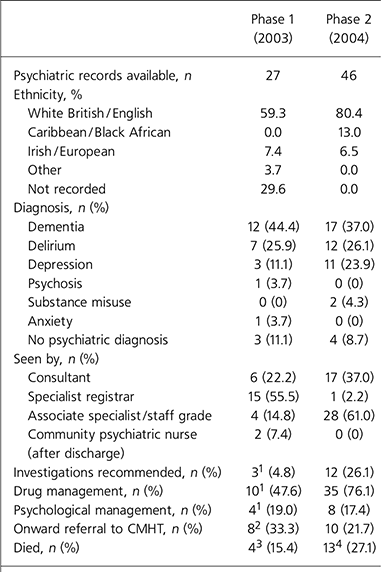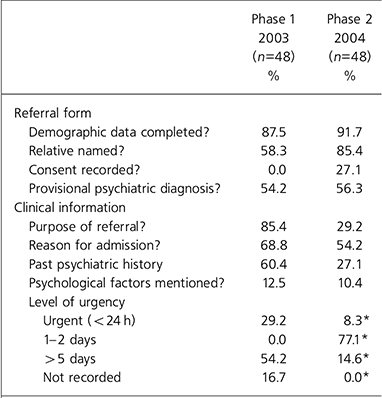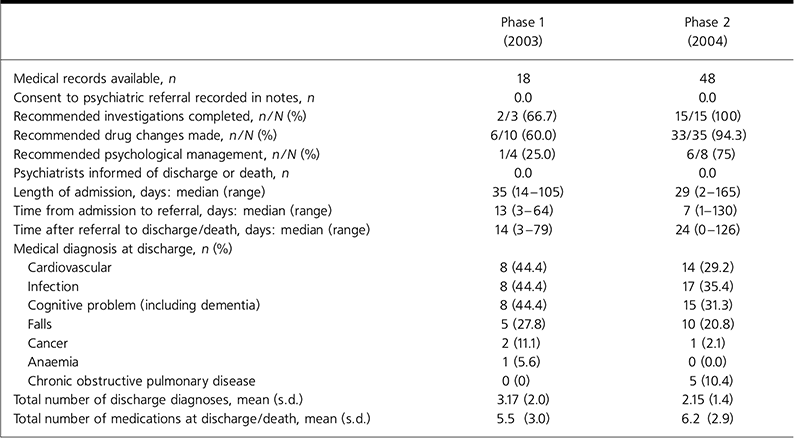Service models differ for the provision of mental healthcare for elderly medical in-patients. Input by the general adult liaison psychiatry service with no age cutoff (Reference LipowskiLipowski, 1983) and sector-based old age community mental health teams (CMHTs) (Reference Scott, Fairbairn and WoodhouseScott et al, 1988; Reference De Leo, Baiocchi and CipolloneDe Leo et al, 1989) have been described, as well as a consultation-liaison model. Holmes et al (Reference Holmes, Bentley and Cameron2003) showed that old age psychiatrists favoured a liaison rather than a consultation model.
The Lewisham Old Age Consultation and Liaison (LOACaL) psychiatry service was set up in November 2003 to serve four care of the elderly wards at University Hospital Lewisham. Elderly medical in-patients were seen prior to this as part of an ‘in-reach’ sector team-based service provided by two old age CMHTs. The new service comprised a consultant psychiatrist (5 sessions), a staff grade doctor (10 sessions), a psychologist (3 sessions) and a nurse (3 sessions). There are 124 care of the elderly beds out of a total of 550 at University Hospital Lewisham. In 2004-2005 there were 56 300 admissions to the hospital as a whole and the average length of stay on a care of the elderly ward at that time was 2 weeks.
Mujic et al (Reference Mujic, Hanlon and Sullivan2004) found that capacity assessments represented a fifth of the workload of an old age liaison service. In an attempt to reduce the number of inappropriate referrals for simple capacity assessments, the new service's referral form had guidelines for assessing capacity printed on the back.
The aims of this study were: to determine the quantity and type of referrals to the new old age liaison psychiatry service; to assess the quality of the referral information provided by the care of the elderly teams and their response to the recommendations made by the liaison team; to assess the response time of the liaison service and the outcomes of the patients seen; to assess the adequacy of the new service's referral form and record the number of capacity referrals.
Method
All requests for a consultation/liaison opinion to the Mental Health of Older Adults CMHT in Lewisham between October 2002 and September 2003 were identified retrospectively from the computer records kept by the South London and Maudsley NHS Trust. In phase 1 of the study, referral details, demographic information and clinical information were obtained from the old CMHT referral form.
The second phase of the study was conducted prospectively and collected data on patients referred in the first year of the new LOACaL service (November 2003 to October 2004). At the inception of the new service a new referral form required the referrer to provide more clinical information, in particular relating to the patient's capacity and consent to psychiatric referral and included a number of ‘tick boxes’ to obtain clinical information more systematically. This information was recorded in addition to phase 1 information. For both phases of the study all available clinical records were then examined from both the Mental Health of Older Adults Service and University Hospital Lewisham. Information was collected from both sets of clinical notes about diagnosis and outcome (discharge destination, onward referral to the CMHT and death). Phase 1 acted as a comparator with which the performance of the new service could be compared in the second phase of the study. Data were analysed using SPSS, version 12 for Windows.
Results
Service activity
All 48 referrals from phase 1 were included and 48 of the 96 referrals from phase 2. In the second phase odd numbered cases were chosen on the toss of a coin to capture a good sample of practice throughout the whole of the first year of the service. In phase 1, only 27 referrals (56%) were seen; 21 referrals were not seen: because they had died (2) or been discharged before assessment (6), verbal advice had been given instead (3), or the reason for referral was a straightforward capacity assessment (6) or placement advice (4). In phase 2, 94 referrals (98%) were seen. Two patients were not seen as they were discharged before assessment could take place. Psychiatric records were available for all people referred but ethnicity data were missing from 14 phase 1 records (29%). Care of the elderly medical records could be found for only 18 referrals in phase 1.
Demographics
Age and gender were not significantly different between the two phases of the study, with the ratio of female:male being 65:35 for phase 1 and 62.5:37.5 for phase 2. Mean age at referral was 84.25 (s.d.=63) years for phase 1 and 82.1 (s.d.=7.1) years for phase 2. The ethnicity profile (Table 1) reflects that of the hospital's catchment area.
Table 1. Results from psychiatric records

| Phase 1 (2003) | Phase 2 (2004) | |
|---|---|---|
| Psychiatric records available, n | 27 | 46 |
| Ethnicity, % | ||
| White British/English | 59.3 | 80.4 |
| Caribbean/Black African | 0.0 | 13.0 |
| Irish/European | 7.4 | 6.5 |
| Other | 3.7 | 0.0 |
| Not recorded | 29.6 | 0.0 |
| Diagnosis, n (%) | ||
| Dementia | 12 (44.4) | 17 (37.0) |
| Delirium | 7 (25.9) | 12 (26.1) |
| Depression | 3 (11.1) | 11 (23.9) |
| Psychosis | 1 (3.7) | 0 (0) |
| Substance misuse | 0 (0) | 2 (4.3) |
| Anxiety | 1 (3.7) | 0 (0) |
| No psychiatric diagnosis | 3 (11.1) | 4 (8.7) |
| Seen by, n (%) | ||
| Consultant | 6 (22.2) | 17 (37.0) |
| Specialist registrar | 15 (55.5) | 1 (2.2) |
| Associate specialist/staff grade | 4 (14.8) | 28 (61.0) |
| Community psychiatric nurse (after discharge) | 2 (7.4) | 0 (0) |
| Investigations recommended, n (%) | 31 (4.8) | 12 (26.1) |
| Drug management, n (%) | 101 (47.6) | 35 (76.1) |
| Psychological management, n (%) | 41 (19.0) | 8 (17.4) |
| Onward referral to CMHT, n (%) | 82 (33.3) | 10 (21.7) |
| Died, n (%) | 43 (15.4) | 134 (27.1) |
Referral form
There was an improvement in the completion of some of the sections of the referral form (Table 2): demographic information, a named relative and provisional psychiatric diagnosis. However, there was a reduction in the completion of others parts of the form: purpose of the referral made clear, reason for medical admission and past psychiatric history. The number of urgent referrals fell from 29.2 to 8.3% (Pearson χ2 P<0.001).
Table 2. Results from referral form

| Phase 1 2003 (n=48) % | Phase 2 2004 (n=48) % | |
|---|---|---|
| Referral form | ||
| Demographic data completed? | 87.5 | 91.7 |
| Relative named? | 58.3 | 85.4 |
| Consent recorded? | 0.0 | 27.1 |
| Provisional psychiatric diagnosis? | 54.2 | 56.3 |
| Clinical information | ||
| Purpose of referral? | 85.4 | 29.2 |
| Reason for admission? | 68.8 | 54.2 |
| Past psychiatric history | 60.4 | 27.1 |
| Psychological factors mentioned? | 12.5 | 10.4 |
| Level of urgency | ||
| Urgent (<24 h) | 29.2 | 8.3* |
| 1-2 days | 0.0 | 77.1* |
| > 5 days | 54.2 | 14.6* |
| Not recorded | 16.7 | 0.0* |
Response of teams
The delay of the Mental Health of Older Adults team in seeing patients (Table 1) was significantly reduced from a median of 4.5 days (range 0-77) in phase 1 to 1 day (range 0-7) in phase 2 (Mann-Whitney U-test P<0.001). In addition, patients were seen on significantly more occasions: a median of 4 times (range 1-17) in phase 2 v. once (range 1-4) in phase 1 (Mann-Whitney U-test P<0.001). More investigations were recommended in phase 2 (26%) than in phase 1 (4.8%); and more medication (76 v. 47%) but less psychological management was recommended (17.4 v. 19%) in phase 1.
There was an improvement in completing the liaison service's recommendations by the care of the elderly teams. For example, two-thirds of medical investigations recommended were acted upon in phase 1 compared with all in phase 2. However, the care of the elderly teams did not communicate information concerning patients’ discharges or deaths to the liaison team.
Diagnoses
Dementia, delirium and depression were the three most common psychiatric diagnoses accounting for 81% of all diagnoses in phase 1 and 87% in phase 2. More people were diagnosed with depression in phase 2 (23.9%) compared with phase 1 (11.1%). The mean number of medical diagnoses at discharge in phase 1 was 3.2 and 2.2 in phase 2. The most common medical diagnostic categories were cardiovascular disorders, infections, falls and cognitive impairment. There was little or no reference to psychiatric diagnoses in medical discharge letters.
Outcomes
Fewer people were referred on for CMHT follow-up in phase 2 (22%) than in phase 1 (33%). More patients died who were assessed in phase 2 (27%) than phase 1 (15.4%), but this was not statistically significant. In phase 2 29% of referrals needed a psychogeriatric admission. Patients were discharged on a variety of medications, with a mean of 5.5 drugs in phase 1 and 6.2 drugs in phase 2.
Consent and capacity
Referrals for capacity assessments fell from 22.9% in 2003 to 6.2% in 2004. A place to record the patient's consent to referral was not available in the phase 1 referral form but was in phase 2; however, only 27% of referral forms in phase 2 recorded that the patient had consented to seeing a psychiatrist. There were 42% of referrals documented to have capacity to consent, and 13% recorded as lacking capacity, but, in 45% of cases, this section of the referral form was left blank.
Table 3. Results from medical records

| Phase 1 (2003) | Phase 2 (2004) | |
|---|---|---|
| Medical records available, n | 18 | 48 |
| Consent to psychiatric referral recorded in notes, n | 0.0 | 0.0 |
| Recommended investigations completed, n/N (%) | 2/3 (66.7) | 15/15 (100) |
| Recommended drug changes made, n/N (%) | 6/10 (60.0) | 33/35 (94.3) |
| Recommended psychological management, n/N (%) | 1/4 (25.0) | 6/8 (75) |
| Psychiatrists informed of discharge or death, n | 0.0 | 0.0 |
| Length of admission, days: median (range) | 35 (14-105) | 29 (2-165) |
| Time from admission to referral, days: median (range) | 13 (3-64) | 7 (1-130) |
| Time after referral to discharge/death, days: median (range) | 14 (3-79) | 24 (0-126) |
| Medical diagnosis at discharge, n (%) | ||
| Cardiovascular | 8 (44.4) | 14 (29.2) |
| Infection | 8 (44.4) | 17 (35.4) |
| Cognitive problem (including dementia) | 8 (44.4) | 15 (31.3) |
| Falls | 5 (27.8) | 10 (20.8) |
| Cancer | 2 (11.1) | 1 (2.1) |
| Anaemia | 1 (5.6) | 0 (0.0) |
| Chronic obstructive pulmonary disease | 0 (0) | 5 (10.4) |
| Total number of discharge diagnoses, mean (s.d.) | 3.17 (2.0) | 2.15 (1.4) |
| Total number of medications at discharge/death, mean (s.d.) | 5.5 (3.0) | 6.2 (2.9) |
Discussion
The institution of an old age consultation/liaison team led to an improvement in service provision; there was an increased case-load but patients were seen more quickly and more often, in keeping with the shift from a consultation-oriented service to a liaison-orientated one; care of the elderly teams more often acted on advice given, and on discharge, fewer onward referrals to the old age CMHTs were made. Patients referred to the service represented the older old (over 80 years), were medically complex, had a greater number of medications at discharge, longer admissions and higher mortality.
The argument for specialist liaison input is strong but, despite this, 73% of services in the UK are provided according to a traditional sector-based model (Reference Holmes, Bentley and CameronHolmes et al, 2003).
In keeping with previous work (Reference Scott, Fairbairn and WoodhouseScott et al, 1988; Reference De Leo, Baiocchi and CipolloneDe Leo et al, 1989), the 3 ‘D's (dementia, delirium and depression) of old age psychiatry represented the main diagnoses. However, referral rates in this population still did not reflect the prevalence rates of cognitive impairment (6-25%) and depression (33-66%) found in other studies (Reference Goring, Baldwin and MarriottGoring et al, 2004). The new service diagnosed more people with depression and fewer with dementia. This change is interesting and reflects the difficulties of diagnosis in this population and highlights the issue of diagnostic overshadowing.
The introduction of a new referral form which requested more discrete items of clinical information (tick boxes) produced mixed results. There was less information gathered about the reason for referral, and the service has now revised the form to remedy this. However, a new ‘1-2 days’ category on the referral form may have contributed, along with increased confidence in a prompt assessment, to the reduction in urgent (<24 h) referrals. Including guidelines for assessing capacity on the form appeared to reduce referrals for this specific reason to 6%. However, this is an area the care of the elderly teams appeared to have difficulty with, as reflected by the poor documentation of consent/capacity on the referral forms. Finally, there may have been many reasons for the absence of records regarding informing the liaison team about patients’ discharge or death.
Declaration of interest
None.








eLetters
No eLetters have been published for this article.